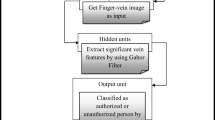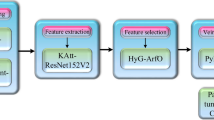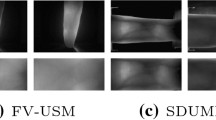Abstract
In the current scenario, Biometric authentication plays a crucial role in the security process by relying on the inimitable genetic characteristics. The process is carried over by registering and comparing the data in the database. Being a vast field it addresses various looms like finger vein, palm vein, hand vein, finger print, palm print, etc. Deep Learning technique is applied for this type of approach based on the requirements. Thus a new intelligent Finger-Vein Recognition Model is proposed which adapts the Deep Learning (DL) techniques for Biometric Authentication Systems with a Decision-Making Tool (DMT). This proposed model enables recognition of Finger Vein related data by making use of a Long-Short-Term-Memory (LSTM-DMT) model adapting DL technique for the finger vein recognition system. Since classification of image is an essential process in this entire authentication system, a decision-making tool using a Deep Stacked Auto Encoder is used for the classification of different vein features that exist in big data. This entire model is designed in such a way that finger-vein Image Acquisition, preprocessing techniques, technique for extracting the features, matching of acquired images with database images, obtaining genuine images and lastly the evaluation of accuracy is carried out. A comprehensive experimental study of result is conceded guarantee betterment of proposed method. The final experimental upshot highlights the advanced better-quality results of proposed method in the matter of diverse measure’s.




Similar content being viewed by others
References
Ahmed ST, Kumar VV, Singh KK, Singh A, Muthukumaran V, Gupta D (2022) 6G enabled federated learning for secure IoMT resource recommendation and propagation analysis. Comput Electr Eng 102:108210
Kapoor K, Rani S, Kumar M, Chopra V, Brar GS (2021) Hybrid local phase quantization and grey wolf optimization based SVM for finger vein recognition. Multim Tools Appl 80(2). Springer
Kono M (2000) A new method for the identification of individuals by using vein pattern matching of a finger. In: Proceedings of the 5th symposium on pattern measurement, Yamaguchi, Japan, pp 9–12.
Kumar VV, Muthukumaran V, Ashwini N, Beschi IS, Gunasekaran K, Niveditha VR (2022) An efficient signcryption scheme using near-ring hybrid approach for an IoT-based system. Int J e-Collaboration (IJeC) 18(1):1–31
Kuzu RS, Piciucco E, Maiorana E, Campisi P (2020) On-the-fly finger- vein-based biometric recognition using deep neural networks. IEEE Trans Inf Forensics Secur 15:2641–2654
Lakshmanaprabu SK, Mohanty SN, Krishnamoorthy S, Uthayakumar J, Shankar K (2019) Online clinical decision support system using optimal deep neural networks. Appl Soft Comput 81:105487
Liu BC, Xie SJ, Park DS (2016) Finger vein recognition using optimal partitioning uniform rotation invariant LBP descriptor. J Electr Comput Eng
Lu Y, Wu S, Fang Z, Xiong N, Yoon S, Park DS (2017) Exploring finger vein based personal authentication for secure IoT. Future Gener Comput Syst 77:149–160
Madhan ES, Neelakandan S, Annamalai R (2020) A novel approach for vehicle type classification and speed prediction using deep learning. J Comput Theor Nanosci 17(5):2237–2242
Madhusudhan MV, Basavaraju R, Hegde C (2019) Secure human authentication using finger-vein patterns. Data management, analytics and innovation. Springer, Singapore, pp 311–320
Madhusudhan MV, Udayarani V, Hegde C (2021) Finger vein recognition model for biometric authentication using intelligent deep learning. Int J Image and Graph. https://doi.org/10.1142/S0219467822400046
Majji R, Gnanaprakasam Om Prakash P, Cristin R, Parthasarathy G (2020) Social bat optimization dependent deep stacked auto encoder for skin cancer detection. IET Image Processing, ISSN: 1751–9659
Matsuda Y, Miura N, Nagasaka A, Kiyomizu H, Miyatake T (2016) Finger-vein authentication based on deformation-tolerant feature-point matching. Mach vis Appl 27(2):237–250
Mishra KN, Mishra KN, Agrawal A (2016) Veins based personal identification systems: a review. I J Intell Syst Appl 8(10):68–85
Neelakandan S, Paulraj D (2020b) An Automated exploring and learning model for data prediction using balanced CA-Svm. J Ambient Intell Human Comput. Springer, pp 1–12, ISSN 1868-5137
Neelakandan S, Paulraj D (2020a) An automated learning model of conventional neural network based sentiment analysis on Twitter data. J Comput Theor Nano Sci 17(5):2230–2236
Noh KJ, Choi J, Hong JS, Park KR (2020) Finger-vein recognition based on densely connected convolutional network using score-level fusion with shape and texture images. IEEE Access 8:96748–96766
Parthasarathy G, Tomar DC (2014) Trends in citation analysis. In: 1st international conference on intelligent computing, communication and devices, 18–19, pp 813–821
Parthasarathy G, Soumya TR, Ramanathan L, Ramesh P (2020) Improvised approach for real time patient health monitoring system using IoT. In: Intelligent systems and computer technology. IOS Press, pp 78–83
Parthasarathy G, Tomar DC (2016) A novel approach for classification and clustering of biomedical citations. Biomed Res-Int J Med Sci. 27:S22–S30
Peng J, Wang N, Ahmed A, Abd Ei-Latif, Li Q, Niu X (2012) Finger-vein verificationusing Gabor filter and SIFT feature matching. In: Proceedings of 8th international conference on intelligence information hiding multimedia signal process, Piraeus, Greece, pp 45–48
Qin H, He X, Yao X, Li H (2017) Finger-vein verification based on the curvature in Radon space. Expert Syst Appl 82:151–161
Raghunath KK, Kumar VV, Venkatesan M, Singh KK, Mahesh TR, Singh A (2022) XGBoost regression classifier (XRC) model for cyber attack detection and classification using inception V4. J Web Eng 1295–1322
SaiSupriya N, Rashmi S, Parthasarathy G, Priyanka R (2021) Face mask detection using CNN. Smart Intell Comput Commun Technol 38:118
Shaheed K, Liu H, Yan G, Qureshi I, Gou J, Yin Y (2018) A systematic review of finger vein recognition techniques. Information 9(9):213
Song J, Kim MKR, Park (2019) Finger-vein recognition based on deep DenseNet using composite images. IEEE Access 7:66845–66863
Tao Z, Zhou X, Xu Z, Lin S, Hu Y, Wei T (2021) Finger-Vein Recognition Using Bidirectional Feature Extraction and Transfer Learning. Mathematical Problems in Engineering. Article ID 6664809
Uthayakumar J, Elhoseny M, Shankar K (2020) Highly reliable and low- complexity image compression scheme using neighborhood correlation sequence algorithm in WSN. IEEE Trans Reliab 69(4):1398–1423
Yang J, Shi Y, Jia G (2017) Finger-vein image matching based on adaptive curve transformation. Pattern Recogn 66:34–43
Zeng J, Wang F, Deng J, Qin C, Zhai Y, Gan J, Piuri V (2020) Finger vein verification algorithm based on a fully convolutional neural network and conditional random field. IEEE Access 8:65402–65419
Zhang Z, Zhong F, Kang W (2021) Study on reflection-based imaging finger vein recognition. IEEE Trans Inform Forens Secur 17
Funding
No research grants are received from any funding agencies or by any organizations in public, commercial or not-for-profit sectors.
Author information
Authors and Affiliations
Corresponding author
Ethics declarations
Conflict of interest
The authors of this publication declare, there is no conflict of interest.
Human and animal participants
Human Participants are not involved in this proposed work. However, publically available database for the finger vein images, SDMULA-HMT is used. No Animals are used in our presented work.
Additional information
Publisher's Note
Springer Nature remains neutral with regard to jurisdictional claims in published maps and institutional affiliations.
Rights and permissions
Springer Nature or its licensor (e.g. a society or other partner) holds exclusive rights to this article under a publishing agreement with the author(s) or other rightsholder(s); author self-archiving of the accepted manuscript version of this article is solely governed by the terms of such publishing agreement and applicable law.
About this article
Cite this article
Madhusudhan, M.V., Udayarani, V. & Hegde, C. An intelligent deep learning LSTM-DM tool for finger vein recognition model USING DSAE classifier . Int J Syst Assur Eng Manag 15, 532–540 (2024). https://doi.org/10.1007/s13198-022-01807-x
Received:
Revised:
Accepted:
Published:
Issue Date:
DOI: https://doi.org/10.1007/s13198-022-01807-x




